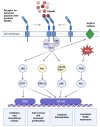The RAGE Pathway in Skin Pathology Development: A Comprehensive Review of Its Role and Therapeutic Potential
- PMID: 39769332
- PMCID: PMC11676465
- DOI: 10.3390/ijms252413570
The RAGE Pathway in Skin Pathology Development: A Comprehensive Review of Its Role and Therapeutic Potential
Abstract
The receptor for advanced glycation end-products (RAGE), a member of the immunoglobulin superfamily, is expressed in various cell types and mediates cellular responses to a wide range of ligands. The activation of RAGE triggers complex signaling pathways that drive inflammatory, oxidative, and proliferative responses, which are increasingly implicated in the pathogenesis of skin diseases. Despite its well-established roles in conditions such as diabetes, cancer, and chronic inflammation, the contribution of RAGE to skin pathologies remains underexplored. This review synthesizes current findings on RAGE's involvement in the pathophysiology of skin diseases, including conditions such as psoriasis, atopic dermatitis, and lichen planus, focusing on its roles in inflammatory signaling, tissue remodeling, and skin cancer progression. Additionally, it examines RAGE-modulating treatments investigated in dermatological contexts, highlighting their potential as therapeutic options. Given RAGE's significance in a variety of skin conditions, further research into its mediated pathways may uncover new opportunities for targeted interventions in skin-specific RAGE signaling.
Keywords: RAGE; fibrosis; inflammation; skin diseases; skin neoplasms.
Conflict of interest statement
The authors declare no conflict of interest.
Figures





Similar articles
-
RAGE and its ligands: from pathogenesis to therapeutics.Crit Rev Biochem Mol Biol. 2020 Dec;55(6):555-575. doi: 10.1080/10409238.2020.1819194. Epub 2020 Sep 16. Crit Rev Biochem Mol Biol. 2020. PMID: 32933340
-
Signal Diversity of Receptor for Advanced Glycation End Products.Acta Med Okayama. 2017 Dec;71(6):459-465. doi: 10.18926/AMO/55582. Acta Med Okayama. 2017. PMID: 29276218 Review.
-
All the "RAGE" in lung disease: The receptor for advanced glycation endproducts (RAGE) is a major mediator of pulmonary inflammatory responses.Paediatr Respir Rev. 2017 Jun;23:40-49. doi: 10.1016/j.prrv.2017.03.012. Epub 2017 Mar 18. Paediatr Respir Rev. 2017. PMID: 28416135 Free PMC article. Review.
-
The RAGE Axis: A Relevant Inflammatory Hub in Human Diseases.Biomolecules. 2024 Mar 28;14(4):412. doi: 10.3390/biom14040412. Biomolecules. 2024. PMID: 38672429 Free PMC article. Review.
-
RAGE and TGF-β1 Cross-Talk Regulate Extracellular Matrix Turnover and Cytokine Synthesis in AGEs Exposed Fibroblast Cells.PLoS One. 2016 Mar 25;11(3):e0152376. doi: 10.1371/journal.pone.0152376. eCollection 2016. PLoS One. 2016. PMID: 27015414 Free PMC article.
Cited by
-
Dihydromyricetin May Attenuate Skin Aging as a RAGE Inhibitor.Nutrients. 2025 May 29;17(11):1862. doi: 10.3390/nu17111862. Nutrients. 2025. PMID: 40507131 Free PMC article.
-
Skin Microbiota: Mediator of Interactions Between Metabolic Disorders and Cutaneous Health and Disease.Microorganisms. 2025 Jan 14;13(1):161. doi: 10.3390/microorganisms13010161. Microorganisms. 2025. PMID: 39858932 Free PMC article. Review.
References
Publication types
MeSH terms
Substances
LinkOut - more resources
Full Text Sources
Medical

